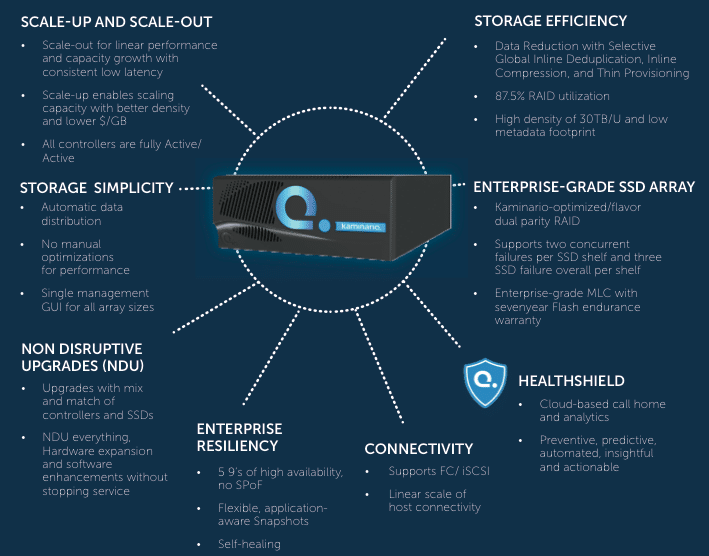Kaminario today announced the release of its fifth-generation K2 primary storage array, which uses the company’s software-defined Scalable Performance Storage Architecture (SPEAR) to leverage commodity hardware for all-flash deployments. According to Kaminario, K2 v5 solutions average two dollars per gigabyte of usable capacity, perhaps the lowest cost per GB in the AFA arena. K2 v5 offers scale-up and scale-out functionality alongside selective global inline deduplication and a range of other mid-market enterprise functionality.
Kaminario today announced the release of its fifth-generation K2 primary storage array, which uses the company’s software-defined Scalable Performance Storage Architecture (SPEAR) to leverage commodity hardware for all-flash deployments. According to Kaminario, K2 v5 solutions average two dollars per gigabyte of usable capacity, perhaps the lowest cost per GB in the AFA arena. K2 v5 offers scale-up and scale-out functionality alongside selective global inline deduplication and a range of other mid-market enterprise functionality.
The Kaminario K2 v5 does not require a dedicated storage administrator to manage and its hardware agnostic architecture helps eliminate forklift upgrades by supporting the mixing and matching controllers and SSDs. K2 v5 deployments can scale from 90TB in 4U up to 720TB in 26U with linear growth in performance. All K2 volumes are thin-provisioned and utilize Kaminario’s K-RAID scheme which is based on RAID6 and uses erasure coding on each shelf of 24 SSDs. K-RAID uses two logical RAID groups that each incorporate a parity drive, with additional parity drive for the two groups overall. This K-RAID layout is pseudo-randomly distributed throughout each shelf with no fixed parity or data role per SSD and no hot spares.
K2 v5 arrays are built from discrete K-Block units. Each K-Block uses two 1U K-Node storage controllers that are deployed in a true active/active configuration and feature two 8Gbps FC ports and two 10GbE iSCSI ports for external host connectivity each. K-Node controllers also incorporate two 40Gbps InfiniBand ports for K-Node backend interconnectivity, two 6Gbps SAS ports for internal connectivity with the K-Block’s SSD shelves, two hot-swappable power supplies, and two hot-swappable battery units. The base SSD shelf has a 2U footprint and incorporates 24 hot-swappable enterprise MLC SSDs along with two hot-swappable controllers and two hot-swappable power supplies.
Selective deduplication allows administrators to designate certain data as outside the bounds of the K2’s deduplication functionality for datasets where redundancy is negligible and additional performance is required or when security policies do not permit deduplication. In addition to its built-in management options, the K2 platform supports integrations with Microsoft VSS, Oracle RMAN, and vCenter via plug-in and VAAI.
Pricing and Availability
The K2 v5 is now available without replication functionality, with replication expected as an update later this year. K2 uses an all-inclusive pricing model, and offers a guarantee that additional hardware will be provided free of cost if the company’s effective capacity calculations are not achieved in the field for its customers.

